Basic AI Chatbot Pricing: A simple chatbot that can answer questions about a product or service might cost around $10,000 to develop.
Read More

How much does it cost to build an AI virtual assistant? If you instantly thought “probably a fortune,” you’re not alone.
But guess what? Businesses that invest wisely in AI assistants are cutting support costs by up to 30% while scaling customer satisfaction at the same time, according to reports.
Every business owner, entrepreneur, and decision-maker wants the shiny benefits of AI, but nobody wants to talk about the price tag until it’s staring them in the face.
The reality? The cost to develop AI Virtual Assistant depends on what you want your assistant to do.
Do you want a simple, “answer FAQs and schedule meetings” type of helper?
Or do you dream of a multi-lingual, sentiment-analyzing, sales-closing digital rockstar?
You can even Create a Personal AI Assistant tailored to your unique workflows.
The features you choose will determine how light or heavy the bill feels.
In this guide, we’re breaking down the AI virtual assistant development cost from every angle. You’ll see what goes into the cost of creating an AI virtual assistant for business, the factors that drive the budget up (or down), the hidden expenses nobody warns you about, and where you can actually save money without cutting corners.
Bottom line: by the time you’re done reading, you won’t just know how much does it cost to build AI virtual assistant. You’ll also know how to make that investment work smarter for your business.
And that’s exactly where we’ll begin by talking about why considering cost upfront is your ultimate competitive edge.
Nobody enjoys talking about costs until it’s too late.
But when it comes to the development cost of AI virtual assistant, ignoring the numbers can set you up for nasty surprises.
Think scope creep, hidden integration fees, or worse, a half-baked assistant that eats up budget without delivering value.
Here’s why considering costs upfront is a power move:
So, while cost might sound like the boring part of innovation, it’s actually the part that makes innovation possible, especially when you partner with a trusted AI Development Company that aligns innovation with budget reality.
Next up, let’s get practical and talk about how to estimate the AI virtual assistant development cost without pulling numbers out of thin air.
Numbers don’t lie. But when you’re planning your budget for an AI assistant, guessing them certainly can. Before you start worrying about six-figure bills, let’s look at a simple way to estimate the AI virtual assistant development cost.
Here’s a straightforward formula that businesses often use:
Total Cost = (Development Hours × Hourly Rate) + Data Preparation + Integrations + Testing + (Maintenance × Years)
Now let’s make it real with an example.
| Cost Component | Estimate (USD) | Notes |
|---|---|---|
|
Development Hours |
800 hrs × $50 = $40,000 |
Based on a mid-level team rate |
|
Data Preparation |
$8,000 |
Cleaning, labeling, and curating training data |
|
Integrations |
$6,000 |
CRM, ERP, or communication tools |
|
Testing & QA |
$5,000 |
Ensures bug-free, reliable assistant |
|
Maintenance (3 years) |
$7,000 × 3 = $21,000 |
Regular updates, bug fixes, scaling |
|
Total Estimate |
~$80,000 |
Example for a mid-tier assistant |
But here’s a variable most people overlook: who builds it. The same project can have very different price tags depending on whether you staff an internal team or outsource it to an experienced partner.
| Build Approach | Estimated Cost Range (USD) | Pros | Cons |
|---|---|---|---|
|
In-House Team |
$120,000–$200,000+ |
Full control, aligned with company culture |
Higher salaries, slower ramp-up, limited expertise |
|
Outsourcing |
$40,000–$120,000 |
Lower cost, faster time-to-market, access to diverse expertise |
Less direct control, requires partner trust |
Outsourcing typically reduces the cost to develop AI virtual assistant by 20–40%, without sacrificing quality if you choose the right partner.
That’s a big swing in savings potential and one worth considering in your early cost estimates.
Estimating cost is less about chasing an exact figure and more about understanding the levers that influence it.
Once you factor in development hours, data needs, integrations, and your build approach, predicting the cost of building AI virtual assistant gets a whole lot easier.
Stop guessing, let’s turn that formula into a real roadmap for your assistant.
Get Your Cost EstimateNow that we’ve crunched the numbers, let’s move into the fun part: the factors influencing cost, and why one business can get started at $10K while another sails past the $150K mark.
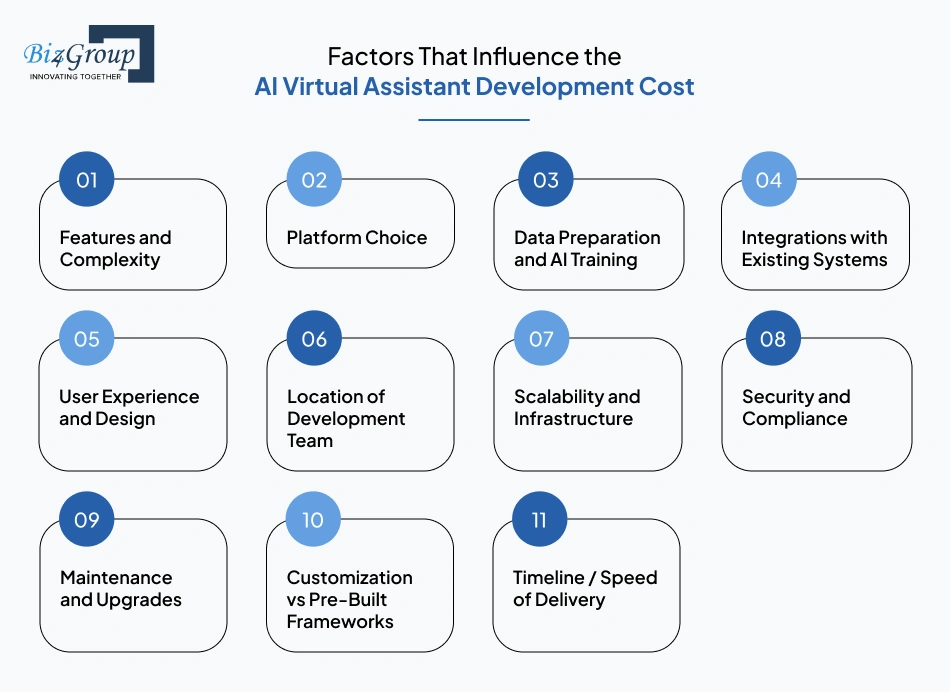
Here’s where things get interesting.
The AI virtual assistant development cost isn’t just a single number pulled from the sky. It’s the sum of a dozen smaller decisions you make along the way.
From the complexity of features to where your dev team sits, every choice has a price tag.
Here’s the big-picture cost tier overview:
| Type of AI Virtual Assistant | Estimated Cost Range (USD) | What You Get |
|---|---|---|
|
MVP / Basic Assistant |
$10,000–$40,000 |
Simple Q&A, FAQ automation, scheduling, limited integrations |
|
Advanced Assistant |
$40,000–$100,000 |
NLP, voice recognition, multi-language support, CRM integration, analytics |
|
Enterprise-Level Assistant |
$100,000–$150,000+ |
Multi-channel, sentiment analysis, decision-making, security & compliance, large-scale integrations |
Now, let’s break down the factors that determine whether your assistant lands at the low or high end of the spectrum:
But partnering with an experienced AI app development company ensures that added complexity translates into real business value.
Pro tip: working with an experienced UI/UX design company can make all the difference in creating a smooth, engaging experience in a budget.
Also read: Top 15 UI/UX Design Companies in USA
So when you ask, what is the cost to make AI virtual assistant, the answer depends on how powerful, polished, and fast you want your digital employee to be.
Just like buying a car, you can drive home in an economical hatchback or a fully loaded luxury SUV, the choice is yours, and the price tag follows.
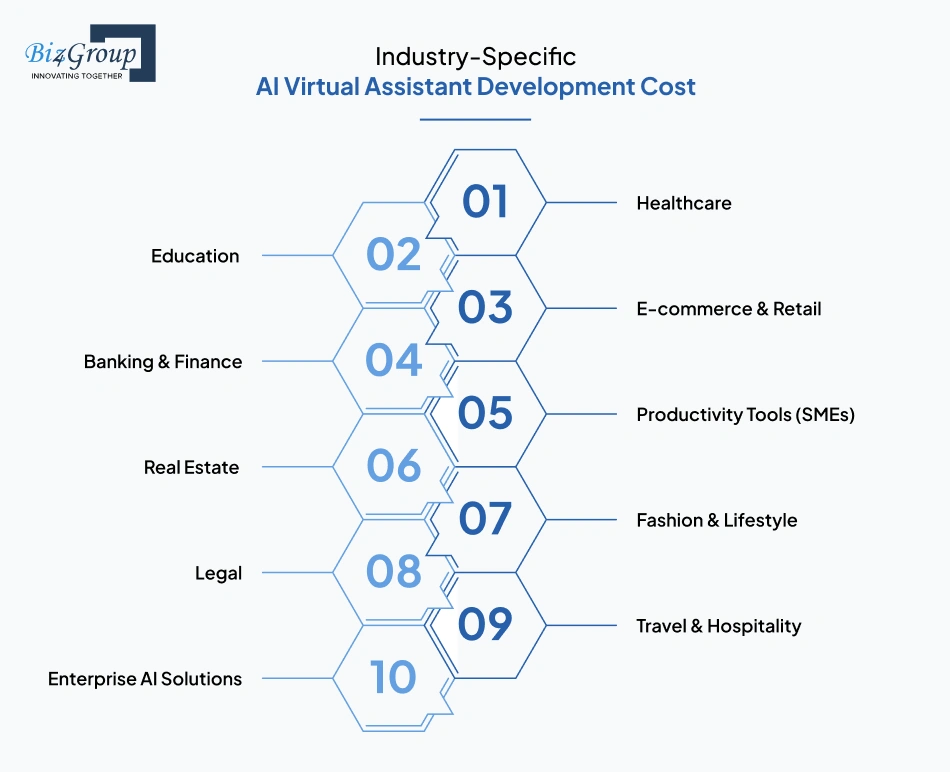
Every industry has its quirks and so do their AI assistants.
The cost of building an AI virtual assistant doesn’t look the same for a hospital as it does for an e-commerce store.
Regulations, integrations, and customer expectations all play a role in shaping the price tag.
Let’s break it down:
| Industry | Typical Use Case | Key Add-Ons | Average Development Cost Range |
|---|---|---|---|
|
Healthcare |
Patient scheduling, symptom checkers, insurance queries |
HIPAA compliance, EMR integration |
$80,000 – $150,000+ |
|
FAQs, grading, student support |
LMS integration, NLP for academic queries |
$50,000 – $120,000 |
|
|
Product recommendations, order tracking, returns |
Payment gateway integration, personalized upselling |
$50,000 – $120,000 |
|
|
Account management, fraud alerts, loan assistance |
High-security protocols, KYC/AML compliance |
$100,000 – $200,000+ |
|
|
Task automation, reminders, team collaboration |
Calendar sync, workflow automation |
$10,000 – $50,000 (MVP to advanced) |
|
|
Property listings, lead nurturing, mortgage FAQs |
MLS integrations, virtual tours |
$60,000 – $110,000 |
|
|
Personalized styling, outfit recommendations |
Trend analysis, AR try-on integration |
$40,000 – $90,000 |
|
|
Document drafting, compliance checks, case FAQs |
Secure document storage, multi-lingual support |
$80,000 – $150,000 |
|
|
Travel & Hospitality |
Booking support, itinerary updates, multilingual chat |
Flight/hotel API integrations, global language support |
$40,000 – $100,000 |
|
Large-scale automation, customer experience platforms, omnichannel support |
High-end integrations, scalability, custom AI models |
$120,000 – $250,000+ |
Curious how those numbers actually come together? Whether you’re building a sleek AI fashion assistant or scaling to enterprise AI solutions, every dollar on that table ties back to a very real development process.
Spoiler: it’s not. From retail to healthcare, assistants are already working overtime.
Schedule a Free CallLet’s peel back the curtain and see where the money really goes, phase by phase.
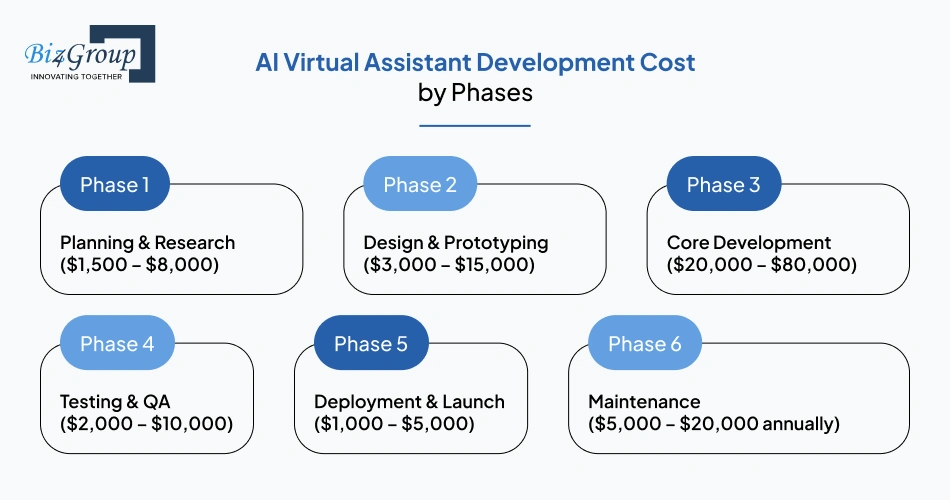
Building an AI virtual assistant isn’t a one-and-done expense. It’s a journey, and every stage of development adds a line to the invoice.
If you’re planning to develop AI virtual assistant for your business, understanding the phase-wise cost distribution can help you budget smarter.
Think of it like building a house: planning, design, construction, inspection, and upkeep all come with their own price tags.
Skipping a stage doesn’t save you money, it usually costs you more later.
Here’s the detailed cost breakdown across the major phases:
| Development Phase | Cost Range (USD) | What’s Included | % of Total Cost |
|---|---|---|---|
|
Planning & Research |
$1,500 – $8,000 |
Market research, scope definition, choosing tech stack, competitor benchmarking |
5–10% |
|
Design & Prototyping |
$3,000 – $15,000 |
UI/UX design, conversation flows, wireframes, user journey mockups |
10–15% |
|
Core Development |
$20,000 – $80,000 |
Backend, frontend, NLP integration, APIs, training, feature development |
60–70% |
|
Testing & QA |
$2,000 – $10,000 |
Functional testing, stress testing, user acceptance testing, bug fixes |
5–10% |
|
Deployment & Launch |
$1,000 – $5,000 |
Cloud setup, security configuration, live environment support |
2–5% |
|
Maintenance (Annual) |
$5,000 – $20,000 |
Updates, bug fixes, retraining models, scaling infra, new features |
15–25% (recurring) |
This is the blueprint stage. Skimp here, and you risk building the wrong thing.
Good planning includes market research, competitor analysis, user needs assessment, and choosing the right tech stack.
Spend a few thousand here and save tens of thousands in “do-overs” later.
Users don’t just want functionality, they want flow.
Great design means mapping out conversations, building intuitive UI/UX, and creating prototypes you can actually test.
A well-designed prototype can reduce rework in development by up to 30%, saving both money and sanity.
This is where most of your money goes. Core development covers frontend, backend, AI/NLP model integration, training, and all the features you promised your stakeholders, the very essence of professional AI product development services.
Complexity is the cost driver here:
Plan for this phase to eat up about two-thirds of your total budget.
Nobody likes buggy bots. Functional tests, stress tests, and user acceptance testing make sure your assistant works smoothly before the big launch.
The rule of thumb? Allocate at least 10% of your total budget here.
It’s cheaper to catch errors now than to fix them while users are already complaining.
Deployment covers cloud hosting, server setup, and final security checks.
This phase is usually light on cost, but heavy on importance. A smooth launch makes the difference between early adoption and early abandonment.
Here’s the part people forget to budget for. AI assistants aren’t a one-time project, they evolve.
Expect to spend 15–25 percent of your initial development cost every year on updates, bug fixes, scaling, and retraining your AI with new data.
Skip this, and your assistant will age faster than your last iPhone.
When you add it all up, the total cost to make a virtual assistant using AI falls between $10,000 and $150,000+, depending on scope and ambition. But more importantly, this breakdown shows you where your dollars are working hardest.
Think of each phase as a checkpoint: plan well, design smart, develop with focus, test thoroughly, launch smoothly, and maintain consistently.
Nail these, and you don’t just control costs, you maximize ROI.
Don’t worry, we’ll help you invest smart at every stage of development.
Contact NowNext, let’s talk about the sneaky line items that rarely make it into cost estimates: the hidden costs of AI virtual assistant development that can derail budgets if you’re not careful.
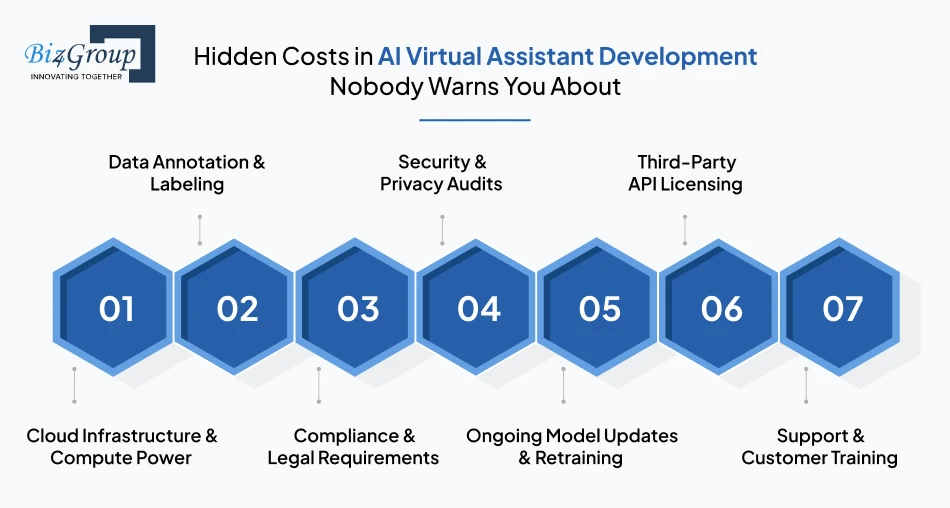
Every budget has fine print, and the AI virtual assistant development cost is no different. These are the sneaky add-ons that don’t always show up in early estimates but can quickly inflate your spend.
Spotting them early is the difference between a smooth project and an “uh-oh, why is this 40 percent over budget?” moment.
Here are the big ones to watch for:
As businesses move toward more autonomous systems, like when they build agentic AI, compliance and governance become even more critical.
Individually, these numbers don’t look terrifying. But together, hidden costs can inflate your budget by 20–40% if you don’t plan for them.
The good news? With careful planning, most of these can be forecasted and negotiated early on.
So far, we’ve covered what influences cost and where the hidden fees lurk. Next up, let’s flip the script and talk about how to optimize your AI virtual assistant development cost, because saving 20 to 40 percent without cutting quality is very much on the table.
Building an AI assistant is like remodeling your house, you can splurge on Italian marble everywhere or be smart about where you invest.
Optimizing your AI virtual assistant development cost is less about penny-pinching and more about steering your budget into the features and workflows that actually drive ROI.
Think of an MVP as your AI’s pilot episode.
Instead of funding a whole season right away, you release a single, tight episode with just the core plotline.
Businesses that launch an MVP typically save 25–35% upfront, while also gathering priceless real-world feedback before expanding.
Also read: Top 12+ MVP Development Companies in USA
Why reinvent natural language processing when Dialogflow or Rasa already nailed it?
Pre-built frameworks can shave 20–30% off your development time, while still leaving room for customization.
It’s like buying a ready-made pizza base, you still get to choose the toppings.
Hiring an internal AI dream team is fantastic, if you’ve got a six-figure budget burning a hole in your pocket.
Outsourcing to an experienced development partner trims the cost to a more manageable $40K–$100K, compared to $120K+ in-house.
Plus, you’re not paying salaries when there’s no active dev work happening.
Here’s a little-known hack: providers like AWS and Azure hand out $5K–$10K in startup credits like candy.
Use them wisely, and you’re instantly cutting 15–20% from your annual infrastructure bill. That’s savings without lifting a finger.
Don’t drop everything at once unless you like cash flow headaches.
A phased rollout (support features now, sales automation later) keeps budgets digestible and risk low.
It’s cost control disguised as strategic growth.
You don’t need to design every wheel from scratch. Repurpose conversation flows, customize prebuilt chatbot modules, and reuse integration templates.
That’s another 10–15% trimmed right off the development tab.
When done right, optimizing the development cost of AI virtual assistants isn’t about “spending less,” it’s about investing smart.
Most businesses that follow these approaches save 20–40% overall while still getting scalable, enterprise-ready assistants.
And once you’ve saved a chunk of cash? That’s when the fun begins because your AI assistant isn’t just about reducing spend. It can actually make you money.
Want Champagne Results on a Lemonade Budget?
Smart shortcuts can save 20–40% without losing quality.
Talk to Our ExpertsIf cutting costs is half the story, making your AI assistant pay for itself is the real plot twist. An AI virtual assistant isn’t just a fancy chatbot, you can create your own AI business assistant that becomes a profit center if you play it right. Here’s how businesses are turning assistants into money-making machines:
| Monetization Strategy | Cost Impact | Revenue / Savings Potential |
|---|---|---|
|
Customer Support That Sells |
Reduces support team cost |
$50K–$100K annual savings + 10–15% AOV lift |
|
Sales Pipeline on Autopilot |
Lowers lead qualification cost |
30% higher conversions + faster revenue |
|
Data as Revenue Fuel |
Utilizes existing ops budget |
Millions in new product-driven revenue |
|
Subscription & Premium Models |
Small incremental dev cost |
20–25% boost in recurring revenue |
|
Cross-Selling & Retention |
Minimal integration cost |
10–20% increase in CLV |
|
Ad Revenue & Partnerships |
Low setup cost |
5–15% incremental revenue growth |
|
White-Labeling Your Assistant |
Higher initial investment |
Full cost recovery in 12–18 months + ongoing licensing income |
Monetization isn’t an afterthought, it’s the ROI engine that justifies your investment.
The total cost of creating an AI-powered virtual assistant for business becomes far less scary when it’s actively generating revenue or saving operational costs every single day.
And if you’re wondering who can help turn all these cost-saving tricks into real dollars, here’s who.
When businesses think about the AI virtual assistant development cost, the first worry is usually “how do we keep it under control without cutting corners?”
That’s where we come in.
At Biz4Group, we’re not just builders, we’re trusted advisors who help companies make the smartest possible investment in their AI journey.
We’ve been in the software game long enough to know that cost optimization isn’t about slashing budgets, it’s about making every dollar work harder.
Whether you’re an ambitious startup or a Fortune 500 enterprise, our focus is simple: helping you spend less, scale faster, and earn more from your AI assistant, the kind of expertise you’d expect from a trusted AI chatbot development company in the USA.
So, why do businesses choose Biz4Group? Let’s break it down:
We know where projects bleed money and how to stop it.
From avoiding redundant integrations to leveraging reusable components, we help clients cut 20–30% of unnecessary spend right out of the gate.
No vague estimates, no “surprise” invoices.
We provide clear cost breakdowns so you know exactly where your investment is going and why.
Our approach covers the whole lifecycle, planning, development, deployment, and post-launch optimization, while keeping overhead lean and efficient.
Think full-service support, minus the fat.
AI assistants are meant to grow with your business, not your budget.
We architect solutions that scale smoothly, so you don’t get hit with exponential costs down the road.
Every business has unique workflows, systems, and customer journeys.
We build assistants that fit like a glove, so you’re not overspending on features you’ll never use.
We don’t just execute your project; we advise you on smarter, future-proof decisions that save money in the long run.
Don’t trust words? Check out our work:
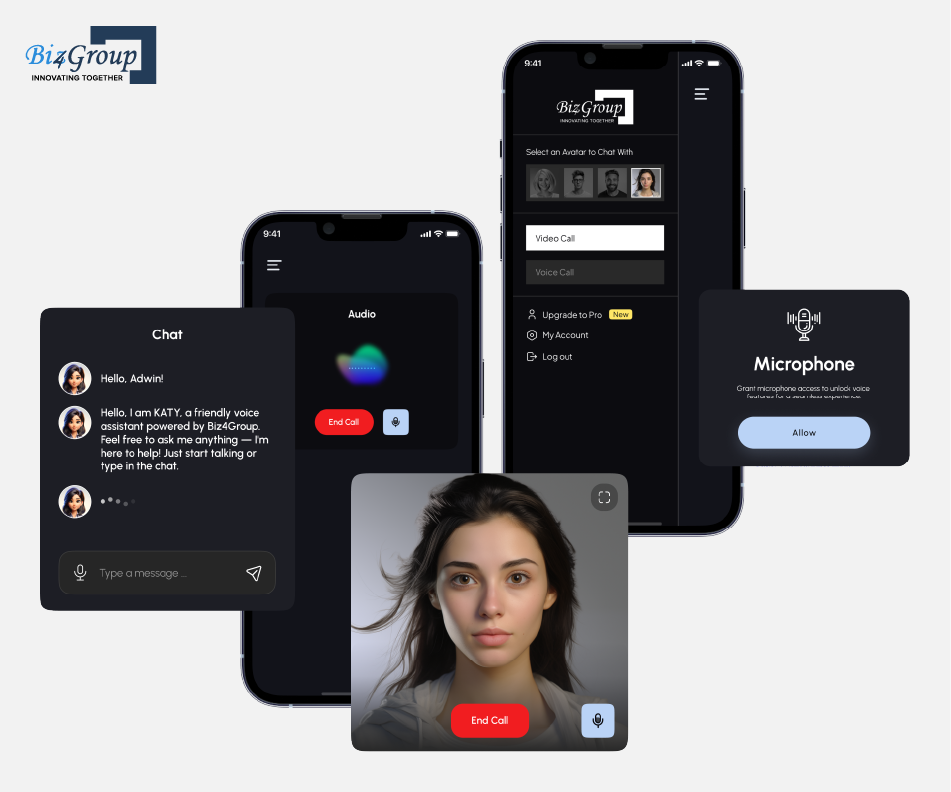
At Biz4Group, we don’t just talk about cost optimization, we deliver it.
One of our proud portfolio highlights is AI Wizard, an avatar-based AI companion designed to serve as a forever empathetic friend through voice and video calls. The project reflects how smart use of integrations, frameworks, and cost-optimization strategies can lead to groundbreaking yet affordable AI solutions.
AI Wizard was envisioned as a personalized avatar-driven AI companion, always ready to assist users during moments of boredom, loneliness, or curiosity. Our team strategically leveraged D-ID for realistic avatar rendering and integrated ChatGPT and Whisper AI for seamless conversational experiences, all while ensuring development costs remained lean without compromising quality.
User Experience Challenges
Solutions: We implemented behavioral data analysis to learn from user interactions and incorporated incremental feature rollouts, ensuring AI Wizard stays engaging and adaptive without inflating costs.
Development & Maintenance Challenges
Solutions: We used incremental learning algorithms to reduce retraining costs and employed React Native for cross-platform development, significantly lowering build and maintenance expenses.
AI Wizard is a perfect demonstration of how Biz4Group keeps development cost optimized without compromising innovation:
The Result: A next-gen AI companion that combines empathy, interactivity, and scalability, built smartly with optimized costs, proving how Biz4Group transforms complex AI visions into budget-conscious realities.
At the end of the day, the cost to develop an AI virtual assistant is only “expensive” if you don’t see a return on it.
Our job is to ensure you do.
That’s why businesses across industries partner with us not just to build, but to thrive.
Ready to optimize your costs and maximize your ROI? Let’s chat.
Because if your AI assistant isn’t working overtime for your business, then maybe it’s time your development partner did.
The real question isn’t what’s the price tag? It’s what’s the payoff? From entry-level assistants starting around $10,000 to advanced enterprise builds that climb above $150,000, the numbers matter, but the real value lies in efficiency gains, reduced overhead, and new revenue streams.
An AI virtual assistant should never be seen as a sunk cost. Done right, it becomes a performance engine, saving hours, scaling customer service, and unlocking opportunities that far outweigh the initial investment.
That’s exactly where Biz4Group makes the difference. As a US-based software development company, we help organizations design assistants that are smarter to build, easier to scale, and quicker to generate returns.
Our focus is simple: keep spending controlled while ensuring your AI delivers measurable business impact.
So, if you’re weighing the cost of creating an AI virtual assistant, think beyond the dollars. Think about ROI, growth, and a partner who knows how to get you there.
Yes. The more users your assistant needs to handle, the higher the infrastructure and licensing requirements. Small-scale deployments can keep costs lean, while enterprise-grade rollouts may need larger budgets to ensure smooth performance.
Often, yes. Many AI solutions rely on third-party APIs, NLP engines, or cloud platforms, which come with monthly or annual fees. While these aren’t always huge, they add up and should be factored into your total cost.
On average, businesses set aside 15–20% of the initial build cost each year for upgrades, bug fixes, and new features. Skipping this budget often leads to outdated assistants that can’t keep up with changing user needs.
In most cases, yes. While the upfront build cost can seem significant, AI assistants don’t take sick days, need training, or require salaries and benefits. Over time, they usually cost a fraction of what businesses spend on live agents.
It varies by industry, but many businesses see a return within the first 6–12 months. Cost savings from reduced labor, faster service, and improved conversions often accelerate payback.
with Biz4Group today!
Our website require some cookies to function properly. Read our privacy policy to know more.